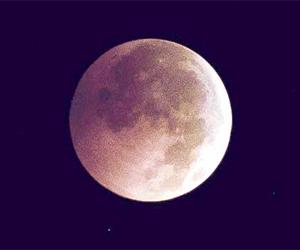The Moon may have emerged from a massive, donut-shaped cloud of a vapourised rock called synestia, rather than being spun out of the aftermath of a collision, a study suggests

 Representational Picture
Representational Picture
ADVERTISEMENT
The Moon may have emerged from a massive, donut-shaped cloud of a vapourised rock called synestia, rather than being spun out of the aftermath of a collision, a study suggests.
"The commonly accepted theory as to how the Moon was formed is that a Mars sized body collided with the proto-Earth and spun material into orbit," said Simon Lock, a graduate student at Harvard University in the US.
"That mass settled into a disk and later accreted to form the Moon. The body that was left after the impact was the Earth. This has been the canonical model for about 20 years," said Lock, co-author of the study published in Journal of Geophysical Research: Planets. According to Lock, it is a compelling story but is probably not correct.
"Getting enough mass into orbit in the canonical scenario is actually very difficult, and there is a very narrow range of collisions that might be able to do it," he said. Tests have shown that the isotopic "fingerprint" for both the Earth and Moon are nearly identical, suggesting both came from the same source.
However, in the canonical story, the Moon formed mostly from the remnants of just one of the two bodies that collided.
Tests have shown that the Moon is far less abundant in many volatile elements - such as potassium, sodium and copper - that are relatively common on Earth.
The scenario outlined by Lock and colleagues still begins with a massive collision, but rather than creating a disc of rocky material, the impact creates a vapourised rock called synestia. "It is huge. It can be ten times the size of the Earth, and because there is so much energy in the collision, maybe 10 per cent of the rock of Earth is vapourised, and the rest is liquid...so the way you form the Moon out of a synestia is very different," Lock said.
It begins with a "seed" - a small amount of liquid rock that gathers just off the centre of the donut-like structure. As the structure cools, vapourised rock condenses and rains down towards the centre of the synestia. Some of the rain runs into the Moon, causing it to grow. "The rate of rain fall is about ten times that of a hurricane on Earth," Lock said.
"Over time, the whole structure shrinks, and the Moon emerges from the vapour. Eventually, the whole synestia condenses and what's left is a ball of spinning liquid rock that eventually forms the Earth as we know it today," said Lock. The whole process happens remarkably fast, with the Moon emerging from the synestia in just a few tens of years, and the Earth forming about 1,000 years later, he said.
"This new work explains features of the Moon that are hard to resolve with current ideas," said Sarah Stewart, a professor at University of California, Davis in the US. "This is the first model that can match the pattern of the Moon's composition," said Stewart.
Catch up on all the latest Crime, National, International and Hatke news here. Also download the new mid-day Android and iOS apps to get latest updates
 Subscribe today by clicking the link and stay updated with the latest news!" Click here!
Subscribe today by clicking the link and stay updated with the latest news!" Click here!






